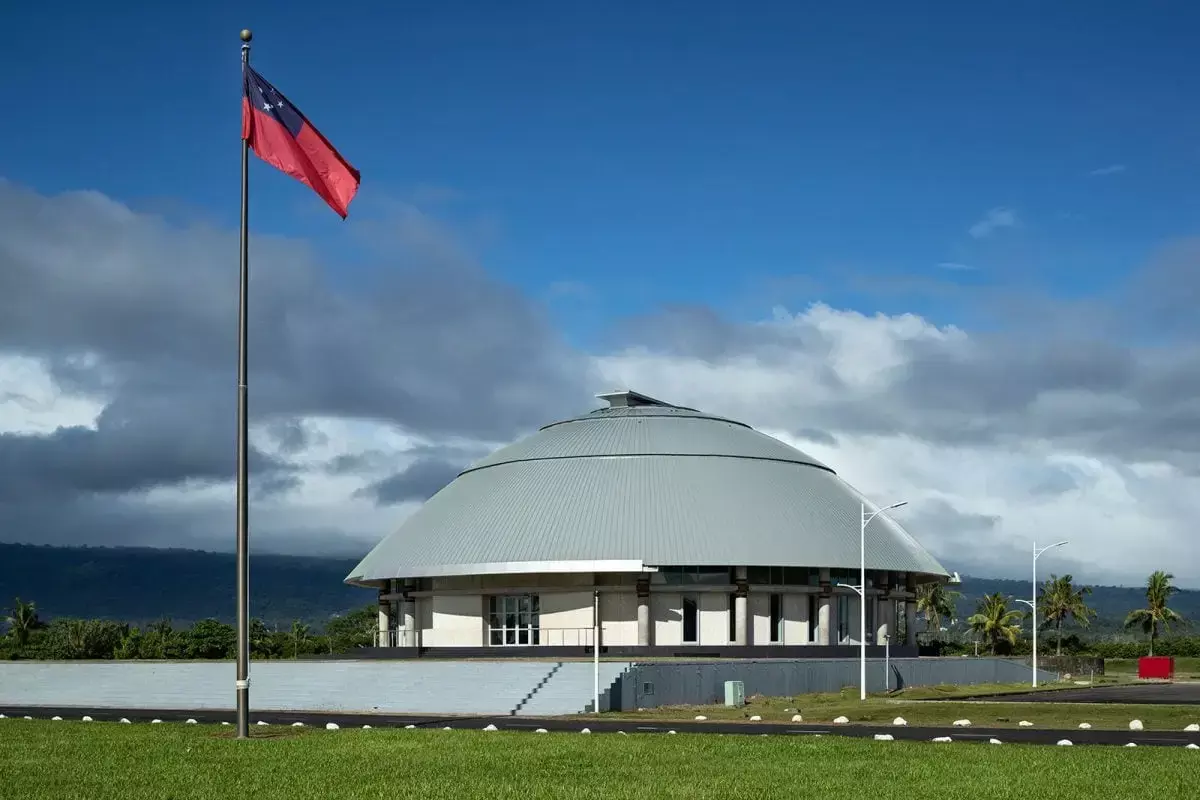
Parliament House of Samoa
Overall Rating: ⭐⭐⭐⭐☆ (4/5)
Rating Breakdown:
✔ Historical Significance – ⭐⭐⭐⭐☆ (4/5)
✔ Cultural Impact – ⭐⭐⭐⭐⭐ (5/5)
✔ Atmosphere & Maintenance – ⭐⭐⭐⭐☆ (4/5)
✔ Accessibility – ⭐⭐⭐⭐☆ (4/5)
✔ Tourist-Friendly – ⭐⭐⭐⭐☆ (4/5)
Weather
- Warm, tropical climate with humidity throughout the year; rain showers are common, especially in the wet season.
Tags
- Government Building, Landmark, Architecture, Civic Site
Timings
- Monday to Friday: 9:00 AM – 4:00 PM
Closed on weekends and public holidays
Time Required
- 30 minutes to 1 hour
Entry Fee
- Free (tours may require advance permission)
Things to See & Do
- Fautea Style Structure – Admire the blend of traditional Samoan architecture with modern design elements.
- Guided Tours – Learn about the Samoan government and political system.
- Photo Opportunity – Capture the unique dome structure with lush surroundings.
- National Flag Raising – Occasionally catch ceremonial events or official gatherings.
Best Time to Visit
- Weekday Mornings when it's cooler and less crowded.
- Dry Season (May to October) is best for clear skies and outdoor exploration.
Nearest Parking Spots
- Designated parking available at the site
- Additional street parking nearby, but limited during official sessions
Overview
- Political Heart of Samoa – Parliament House (Maota Fono) is where national decisions are made, playing a central role in Samoan governance.
- Symbol of Independence – Built after Samoa’s independence in 1962, the structure reflects the pride and self-governance of the nation.
- Architectural Blend – The dome-like design and traditional fale-inspired structure combine cultural identity with civic importance.
- Open for Visitors – While not a typical tourist attraction, visitors can explore the grounds and occasionally access guided tours inside.
- Peaceful Surroundings – Located near the waterfront and surrounded by gardens, it provides a serene environment to reflect on Samoa’s journey as a nation.
- The Dome Structure – A striking white roof resembling the traditional Samoan fale, symbolizing unity and shelter.
- Flagpoles and National Flags – Often seen fluttering in front of the building, especially during state occasions.
- Independence Monument Nearby – Located within walking distance, adding more historical context to the area.
- Decorative Gardens – Well-maintained lawns and tropical plants add to the site's charm and photogenic appeal.
- Following Samoa’s independence from New Zealand in 1962, the need for a central legislative building led to the construction of the Maota Fono.
- It serves as the meeting place for the Samoan Legislative Assembly, housing the 51-member parliament that governs the country.
- The original Parliament House was located elsewhere before this modern structure was constructed at Mulinu’u Peninsula.
- Throughout the years, the building has been the venue for key legislative decisions, state visits, and national commemorations.
- Its design was intended to reflect Samoan cultural values while representing the democratic ideals of a young, independent nation.
- The Parliament House’s iconic dome takes inspiration from traditional fale structures, featuring open walls, high wooden ceilings, and circular symmetry.
- Its layout is symbolic of open dialogue, equality, and unity – core values of Samoan culture and governance.
- Modern materials are used, but the aesthetics remain deeply rooted in Samoan identity, combining tradition with functionality.
- The building is painted in neutral tones, blending harmoniously with the surrounding greenery and ocean views.
- Interior areas (when accessible) display Samoan carvings, artifacts, and traditional motifs, enhancing cultural authenticity.
- Request Access in Advance – Contact local officials if you're interested in a guided interior tour.
- Respect Ceremonial Events – Avoid visiting during state functions or parliament sessions unless permitted.
- Stay Quiet and Courteous – As an active government site, maintain respectful behavior on the grounds.
- Dress Appropriately – Opt for modest and neat clothing, especially if entering the building.
- Pair Your Visit – Combine with a stop at the nearby Independence Monument or Robert Louis Stevenson Museum.
- Location – Situated on the Mulinu’u Peninsula, west of central Apia
- By Taxi – Taxis are readily available and inexpensive from Apia town center
- By Foot or Bike – Scenic 10–15 minute walk from downtown along the waterfront
- Public Transport – Local buses don’t go directly to the site, so taxis or walking are preferred
- Parking Availability – Parking available on the premises, though limited during official events